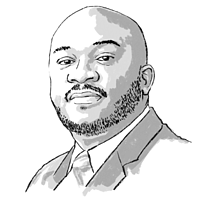In ‘The Wild Robot,’ a 5-star fable for our AI age
Loading...
The new movie “The Wild Robot” may draw comparisons to “The Iron Giant,” which also featured an automated protagonist. Yet my experience with the film, which is rightfully generating Oscar buzz, took me back to another cult classic starring an android – “Bicentennial Man.”
Like the late Robin Williams’ interpretation of artificial intelligence, this wild robot, named ROZZUM unit 7134 and voiced dynamically by Lupita Nyong’o, was also designed to serve. Much like in Williams’ more physical performance, the magical moments happen when both the plot and the actor introduce humanity into a sci-fi film.
It’s a perfect movie for this technological age – fast-paced and full of skepticism. An automated delivery gone awry forces our friendly robot from the heavens to earth, into a wilderness devoid of humans. At first, the fable’s message appears to be about the ills of technology and how it can corrupt a (seemingly) peaceful animal populace. But what eventually happens is that technology becomes a mirror – devices show us our own vices and values.
Why We Wrote This
A story focused on“The Wild Robot” is a love story about community and intimacy. It is the quintessential fable. The wilderness might be harsh, but we don’t have to be.
Ultimately, “The Wild Robot,” which is directed by Chris Sanders and adapted from a trilogy by Peter Brown, is about life itself. It’s about our human attempts to make things better. And it’s much like the seasons, nature’s cyclical attempts to refine and refresh our mistakes. And yet love covers a multitude of sins, evidenced in the unorthodox parenthood expressed among the robot, a hungry fox (voiced by Pedro Pascal), and a gosling (Kit Connor). When the gosling, Brightbill, attempts to pronounce the robot’s given name, our machine offers a nickname: “Roz.”
As the movie shows early and often, Roz’s best ability is adaptability. She imitates various animals and species, not just to survive, but also to be social. Her efforts don’t always go to plan, but that doesn’t deter our protagonist, and it’s part of the movie’s charm. That sense of optimism not only turns a predatory fox into an unsuspecting father, but also turns the food chain from a pecking order to an organized community.
This fable’s attention to detail is breathtaking, from its crisp animated visuals to its investment in individual stories aligning together with the main plot, like birds in formation. Even Roz’s eternal optimism has a foil, in the cybernetic Vontra, whose chippy demeanor doesn’t belie her villainy, but synthesizes it. In some ways, it reminded me of Nyong’o’s role as both protagonist and antagonist in “Us.” Here, though, Vontra is voiced by Stephanie Hsu. Cheeriness can be programmed, but not humanity, nor shared experiences.
For those who are understandably skeptical of technology, especially of AI and its various incarnations, “The Wild Robot” might be a tougher sell. By movie’s end, a foreign machine and programming source has successfully integrated its way into a community. But that summation would be shortsighted. “The Wild Robot” goes to great effort to distinguish software from malware and friend from foe. When the corporation who built Roz makes its appearance, it displays the duality between altruism and overreach.
And yet all of those themes seem to pale in comparison with the relationship between parent and child, an enduring circle of life that never grows old. Certainly, an alien robot taking a gosling under its wing sounds awkward, but how many times have we been out of tune with our own children? Yet we persevere, declaring the other is doing the best they can.
“The Wild Robot,” above all else, isn’t just a life story. It’s a love story about community and intimacy, about what can be imitated, but never duplicated. It is the quintessential fable. Like any great parent, it offers lessons while remaining fun. The wilderness might be harsh, but we don’t have to be.
“The Wild Robot” is rated PG for action/peril and thematic elements.






